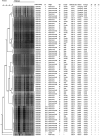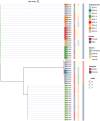Antimicrobial resistance and genomic analysis of Vibrio parahaemolyticus isolates from foodborne outbreaks, Huzhou, China, 2019-2023
- PMID: 39323890
- PMCID: PMC11422088
- DOI: 10.3389/fmicb.2024.1439522
Antimicrobial resistance and genomic analysis of Vibrio parahaemolyticus isolates from foodborne outbreaks, Huzhou, China, 2019-2023
Abstract
Objective: The purpose of this study was to investigate the epidemiological and genomic characteristics of Vibrio parahaemolyticus (V. parahaemolyticus) isolates from outbreaks in Huzhou, China.
Methods: This study aims to analyze the epidemiological data on V. parahaemolyticus outbreaks reported in Huzhou from 2019 to 2023. A total of 70 V. parahaemolyticus outbreak isolates were collected. The antibiotic resistance, serotypes, molecular typing, and genomic characteristics of these isolates were analyzed.
Results: Most outbreaks of V. parahaemolyticus infection occurred in the summer, and the majority of outbreaks occurred in restaurants and rural banquets. High resistance rates were observed for ampicillin (AMP, 24.29%), followed by tetracycline (TET, 15.71%) and trimethoprim-sulfamethoxazole (SXT, 15.71%). The newly emerged serotype O10:K4 became dominant from 2021 to 2023, with most isolates belonging to ST3. The resistance gene blaCARB was frequently detected among these isolates. The pulsed-field gel electrophoresis (PFGE) and whole-genome single-nucleotide polymorphisms (wgSNPs) effectively differentiated the nine outbreaks.
Conclusion: The newly emerged serotype O10:K4 became dominant from 2021 to 2023, with most isolates being ST3. PFGE and WGS technologies provided reliable methods for typing and identifying V. parahaemolyticus for outbreaks.
Keywords: PFGE; Vibrio parahaemolyticus; WGS; foodborne disease; outbreak.
Copyright © 2024 Yan, Ji, Dong, Chen, Yuan and Zhang.
Conflict of interest statement
The authors declare that the research was conducted in the absence of any commercial or financial relationships that could be construed as a potential conflict of interest.
Figures




Similar articles
-
Emergence and predominance of a new serotype of Vibrio parahaemolyticus in Huzhou, China.Int J Infect Dis. 2022 Sep;122:93-98. doi: 10.1016/j.ijid.2022.05.023. Epub 2022 May 11. Int J Infect Dis. 2022. PMID: 35568367
-
Epidemiological and Whole-Genome Sequencing Analysis of a Gastroenteritis Outbreak Caused by a New Emerging Serotype of Vibrio parahaemolyticus in China.Foodborne Pathog Dis. 2022 Aug;19(8):550-557. doi: 10.1089/fpd.2022.0002. Epub 2022 Jul 5. Foodborne Pathog Dis. 2022. PMID: 35787152
-
Pathogenic characteristics of the Vibrio parahaemolyticus which caused a gastroenteritis outbreak event in Huzhou.FEMS Microbiol Lett. 2024 Jan 9;371:fnad130. doi: 10.1093/femsle/fnad130. FEMS Microbiol Lett. 2024. PMID: 38066691 Free PMC article.
-
Vibrio parahaemolyticus O10:K4: An Emergent Serotype with Pandemic Virulence Traits as Predominant Clone Detected by Whole-Genome Sequence Analysis - Beijing Municipality, China, 2021.China CDC Wkly. 2022 Jun 3;4(22):471-477. doi: 10.46234/ccdcw2022.106. China CDC Wkly. 2022. PMID: 35812779 Free PMC article.
-
Antibiotic Resistance and Epidemiology of Vibrio parahaemolyticus from Clinical Samples in Nantong, China, 2018-2021.Infect Drug Resist. 2023 Dec 4;16:7413-7425. doi: 10.2147/IDR.S432197. eCollection 2023. Infect Drug Resist. 2023. PMID: 38077299 Free PMC article.
Cited by
-
Antimicrobial Resistance and Genomic Characterization of Salmonella Serovars Typhimurium and 4,[5],12:i:- in Huzhou, China.Infect Drug Resist. 2025 May 31;18:2765-2777. doi: 10.2147/IDR.S521802. eCollection 2025. Infect Drug Resist. 2025. PMID: 40469478 Free PMC article.
-
Prevalence and Genomic Characterization of Vibrio parahaemolyticus Isolated from a Vast Amount of Aquatic Products in Huzhou, China.Foods. 2025 Jul 15;14(14):2481. doi: 10.3390/foods14142481. Foods. 2025. PMID: 40724302 Free PMC article.
References
-
- Chen Y., Chen X., Yu F., Wu M., Wang R., Zheng S., et al. . (2016). Serology, virulence, antimicrobial susceptibility and molecular characteristics of clinical Vibrio parahaemolyticus strains circulating in southeastern China from 2009 to 2013. Clin. Microbiol. Infect. 22, 258.e9–258.e16. doi: 10.1016/j.cmi.2015.11.003 - DOI - PubMed
LinkOut - more resources
Full Text Sources

